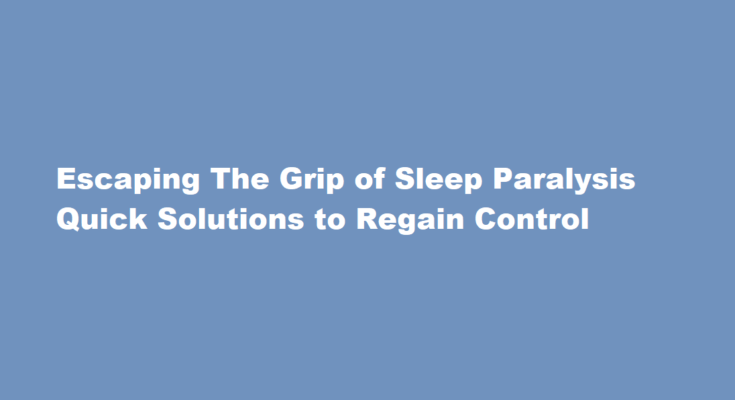Introduction
Sleep paralysis is a haunting experience that leaves individuals feeling trapped in their own bodies, unable to move or speak while their minds remain alert. This phenomenon occurs when a person transitions between sleep stages, and for some, it can be a recurring and terrifying occurrence. However, there are effective strategies to immediately break free from the grasp of sleep paralysis and regain control over your body and mind. In this article, we will explore various techniques to help you swiftly overcome sleep paralysis and prevent it from disrupting your peaceful slumber.
Understanding Sleep Paralysis
Sleep paralysis occurs when a person is temporarily unable to move or speak while falling asleep or waking up. It often accompanies vivid hallucinations and a feeling of impending doom, making it a truly unsettling experience. This phenomenon arises when the brain fails to transition smoothly between the sleep stages, specifically between rapid eye movement (REM) sleep and wakefulness. During REM sleep, our muscles naturally become temporarily paralyzed to prevent us from acting out our dreams. Sleep paralysis occurs when this muscle paralysis continues upon waking up or falling asleep, leaving us temporarily immobilized.
Maintain Calmness
One of the most critical steps in breaking free from sleep paralysis is to remain calm. While it’s an understandably frightening experience, panic only exacerbates the situation. Remind yourself that sleep paralysis is a transient and harmless phenomenon. Focus on regulating your breathing, taking slow, deep breaths to calm your nervous system and relax your muscles.
Attempt Controlled Movements
During a sleep paralysis episode, try to regain control by making subtle movements. Start by wiggling your toes or fingers. This deliberate action can often signal to your brain that you are awake, helping to break the paralysis. Gradually work your way up to larger muscle groups, like your arms or legs, until you regain full mobility. It may take some effort and patience, but persistence is key.
Visualize a Safe Space
As you attempt to move, visualize yourself in a safe and peaceful place. This mental imagery can provide comfort and serve as a distraction from the eerie sensations accompanying sleep paralysis. Imagine yourself floating above the situation, looking down on it from a place of control and serenity.
Focus on Your Breath
Concentrate on your breathing to help ground yourself. Deep, deliberate breaths can help disrupt the cycle of panic and fear, allowing your body to relax. Inhale deeply for a count of four, hold for four, and exhale for four. Repeat this pattern until you regain full control over your body.
Use Sound as a Trigger
Many people find that creating a small noise, like a low hum or a faint whisper, can help break the paralysis. This action engages your vocal cords and can signal to your brain that you are awake. Experiment with gentle vocalizations, and don’t be discouraged if it doesn’t work immediately – it might take a few attempts.
Maintain a Consistent Sleep Schedule
Preventing sleep paralysis in the long term is just as important as escaping it in the moment. Establish a regular sleep schedule by going to bed and waking up at the same time every day, even on weekends. This helps regulate your body’s internal clock and reduces the likelihood of sleep disruptions.
Reduce Stress and Anxiety
High levels of stress and anxiety can increase the likelihood of experiencing sleep paralysis. Engage in relaxation techniques such as meditation, yoga, or deep breathing exercises to alleviate stress. Additionally, consider seeking professional help if you struggle with chronic anxiety or stress, as managing these underlying issues can significantly reduce the occurrence of sleep paralysis.
Frequently Asked Questions
How do you get out of sleep paralysis fast?
There are no proven therapies that can stop a sleep paralysis episode, but most people who experience it routinely report that focusing on making small body movements (such as moving one finger, then another) helps them to recover more quickly.
Can you close your eyes during sleep paralysis?
Sleep paralysis lasts from a few seconds up to several minutes. During this time, you can breathe and open and close your eyes, but your body is still in REM mode, which can make you feel like you’re paralyzed.
Conclusion
Sleep paralysis can be a frightening experience, but with the right techniques, you can swiftly regain control over your body and mind. Remember to stay calm, attempt controlled movements, and use visualization and sound as triggers. By maintaining a consistent sleep schedule and reducing stress and anxiety in your daily life, you can also prevent sleep paralysis from recurring. With these strategies, you can ensure that your nights are peaceful and free from the grip of sleep paralysis.
Read Also : Exploring The Enigma of Sleep Paralysis A Guide to Understanding and Managing the Phenomenon



